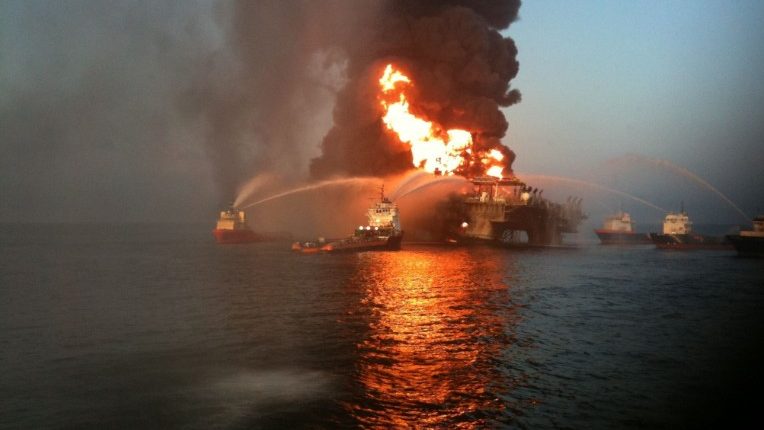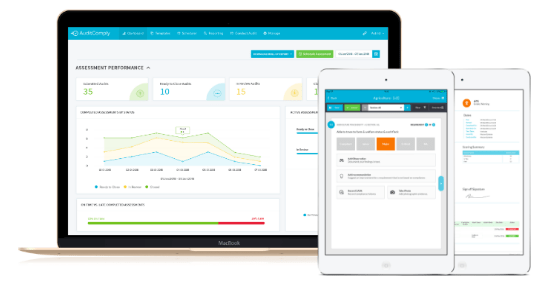
“Within seconds, a bright, white flash erupted on the lower deck of West Delta 105 E, an oil-production platform positioned a dozen miles off the Louisiana coast. Disoriented, one crewmember found himself 10 feet away from where he had been working before he blacked out. Another likened the impact to a sledgehammer blow to his head. A third told investigators he felt like he’d been hit by an 18-wheeler, his hard hat, glasses and earplugs knocked off in the blast.” (NPR)
(Deepwater Horizon On Fire, Source: CNN)

Eight years ago, on 20 April 2010, a rig, drilling at the Moncondo Prospect became engulfed in a fireball, a fireball which could be seen from over 40 miles away. The uncontrollable explosion aboard the Deepwater Horizon caused the deaths of 11 crewmen, injuring 38. For two whole days, the coast guard fought the inextinguishable fire and on 22 April 2010, Deepwater Horizon sank, leaving the oil rig’s well gushing oil across the Mexican Gulf seabed, inevitably leading to the largest ever oil spill in U.S waters.
On July 15, 2010, 86 days later, British Petroleum (BP) temporarily capped the oil well, closing the first stage of what would be the largest and most expensive environmental disaster the petroleum industry has ever seen. Fast forward to present day, BP is now nearing the end of their $65bn Deepwater Horizon compensation process. In 2017 ( 7 years later) BP paid out more than $3bn in compensation.
Final reports of the disaster demonstrate that multiple risk management failures were the leading factors to the disaster. An investigative panel “found no evidence that BP performed a formal risk assessment of critical operational decisions made in the days leading up to the blowout. BP’s failure to fully assess the risks associated with a number of operational decisions leading up to the blowout was a contributing cause of the Macondo blowout.”. (EHS Today)
The report also said cost or time-saving decisions made by BP “without considering contingencies and mitigation” contributed to the disaster, as was the energy company’s “failure to ensure all risks associated with operations on the Deepwater Horizon were as low as reasonably practicable”. (FT)
In the case of Risk & EHSQ management, there are no shortcuts to safety. BP stated the incident occurred due to the failure of eight different safety systems. No matter the size of the organization, the industry or the product offering, eight safety failures is inexcusable, especially when we consider the impact of each safety failure on this occasion. What’s even more concerning, it took a disaster like the Moncondo blowout for organizations to take risk mitigation and safety seriously again.
At AuditComply, we know more assessments equal safer work environments. One of AuditComply’s current customers, Bushmills, performs multiple inspections and assessments every day as they maintain the highest level of quality and safety at the oldest distillery in the world! This is phenomenal and means more than just minimizing overall costs, they have a reputation to uphold.
To prevent any type of hazard, whether you operate in Oil & Gas, Healthcare, Automotive, Manufacturing, Food & Beverage or Finance, risk needs to be effectively assessed at every stage with the potential impact measured. Had BP or Transocean staff used a Risk & Performance platform like AuditComply to conduct a hazard assessment on the Deepwater Horizon, issues would have been detected earlier, the explosion would have been prevented, crew members may still be alive and the subsequent oil spill avoided.
The AuditComply team understand EHSQ & Risk Management professionals deal with a continuous battle to justify spending on Risk & Performance platforms. However, considering in the UK alone, the cost associated with workplace accidents is £4.9bn per year (HSE– Costs to Britain of workplace fatalities and self-reported injuries and ill health, 2013/14), safety isn’t just a nice thing to do for your workers, it has economic benefits as well.
Safety incidents such as Deepwater Horizon highlights the importance of staying on top of your risk management initiatives. Organizations need to become risk conscious, from board level down.
AuditComply’s Risk & Performance platform allows organizations to stay ahead of the curveball when it comes to compliance, quality, safety and risk. AuditComply, a software platform which is utilized by multiple high profile organizations across various industry types and has become the first line of defense around any operational uncertainty.
Large energy companies need to understand the importance of maintaining compliance with such industry standards as such as ISO/TS 29001:2010, ISO9001, ISO14001 – All of which can be met and managed with the AuditComply Risk & Performance Platform.
Why AuditComply?
–AuditComply provides a centralized Risk & Performance software with a range of unique features and solutions. EHS management, quality management, regulatory Compliance, risk mitigation & performance management.
–Real-time reporting allows early identification of potential threats and hazards – Mitigating risk immediately.
–Assess Risk & Performance anywhere and maintain safety with the AuditComply mobile app.
–Multi-site visibility for senior managers and board members.
–Streamline your business processes and increase your competitive advantage.
–Automatic report generation, grading and scoring, offline capabilities, mobile application and much more with AuditComply.

